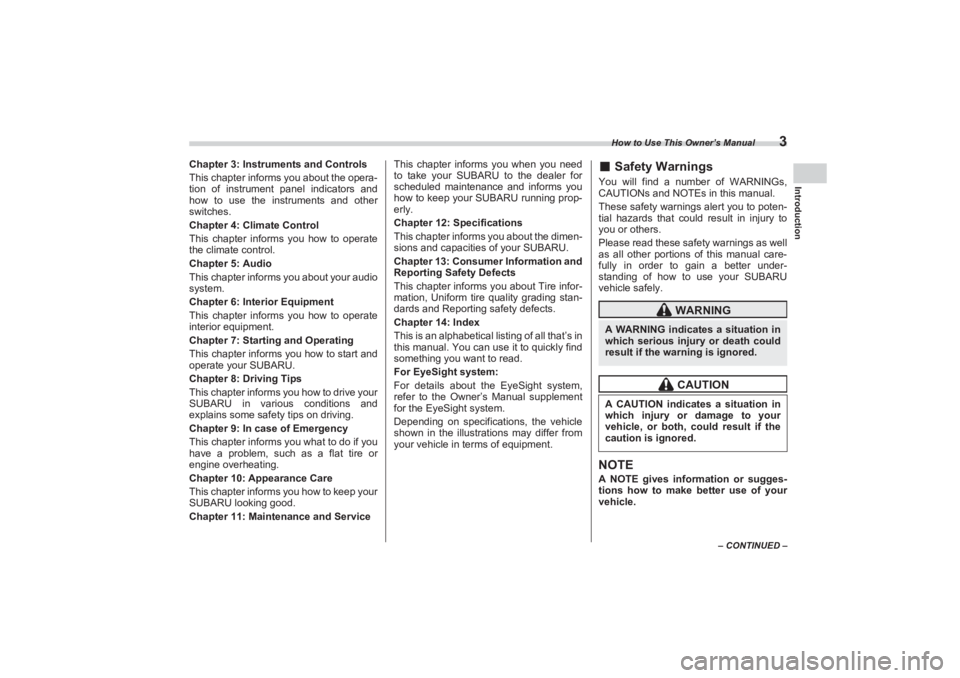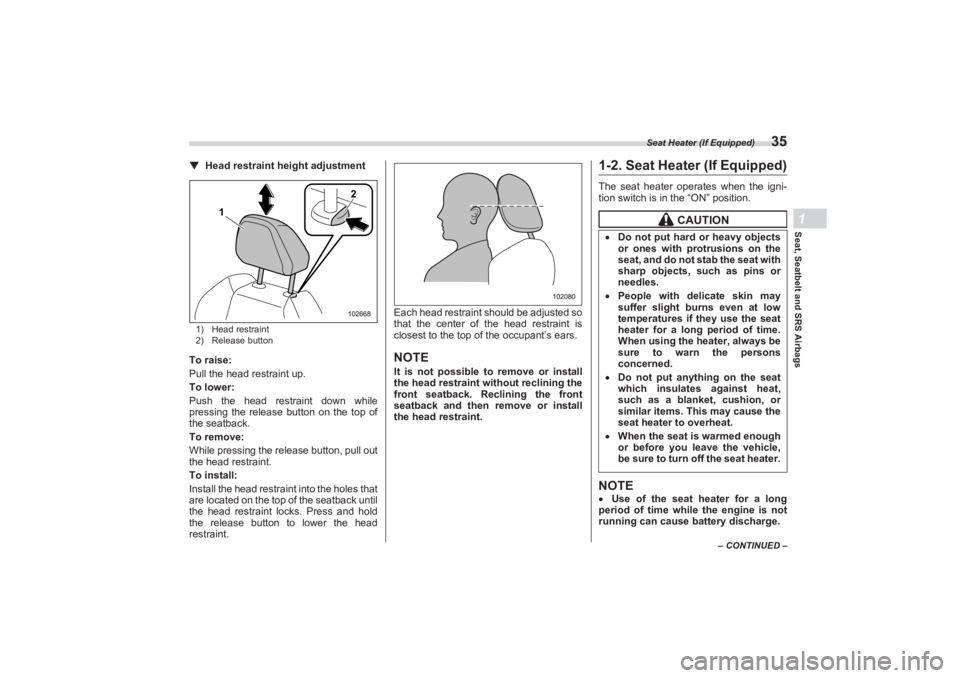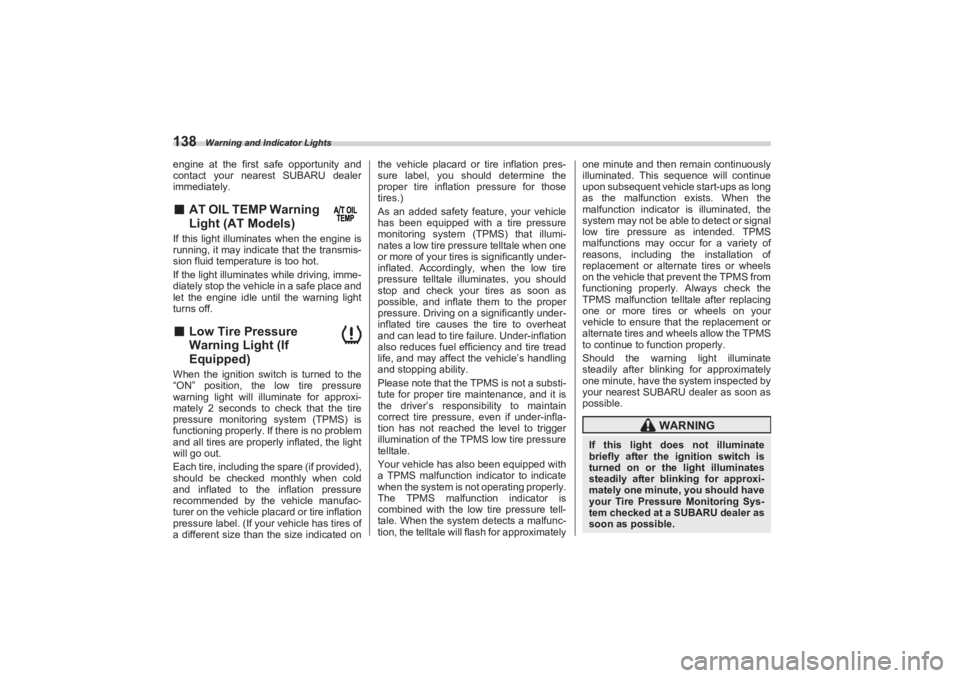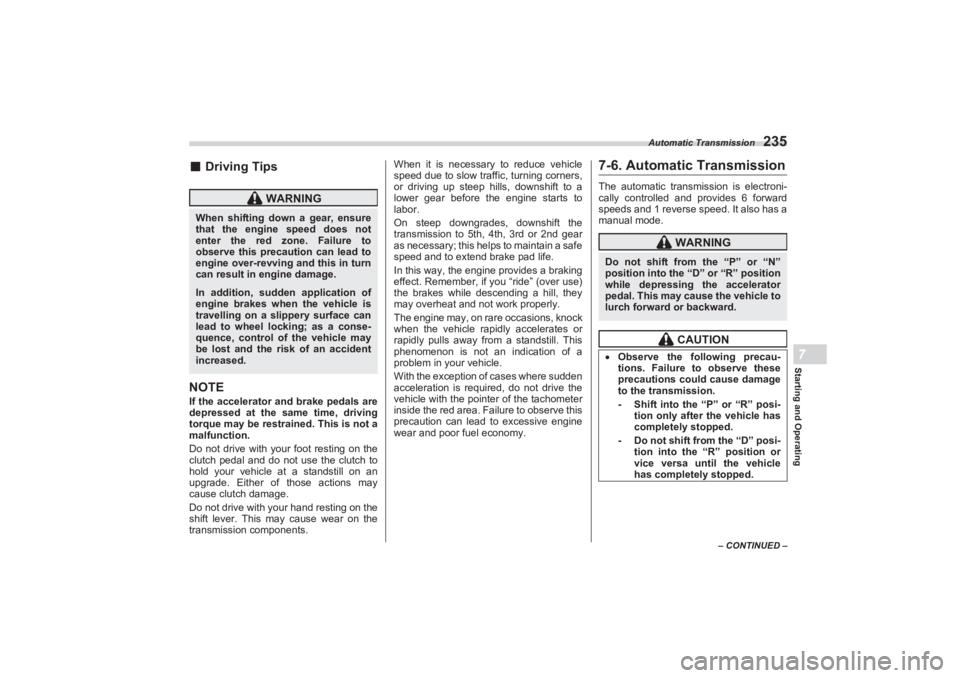2023 SUBARU BRZ engine overheat
[x] Cancel search: engine overheatPage 9 of 432

How to Use This Owner’s Manual
3
Introduction
– CONTINUED –
Chapter 3: Instruments and Controls
This chapter informs you about the opera-
tion of instrument panel indicators and
how to use the instruments and other
switches.
Chapter 4: Climate Control
This chapter informs you how to operate
the climate control.
Chapter 5: Audio
This chapter informs you about your audio
system.
Chapter 6: Interior Equipment
This chapter informs you how to operate
interior equipment.
Chapter 7: Starting and Operating
This chapter informs you how to start and
operate your SUBARU.
Chapter 8: Driving Tips
This chapter informs you how to drive your
SUBARU in various conditions and
explains some safety tips on driving.
Chapter 9: In case of Emergency
This chapter informs you what to do if you
have a problem, such as a flat tire or
engine overheating.
Chapter 10: Appearance Care
This chapter informs you how to keep your
SUBARU looking good.
Chapter 11: Maintenance and Service This chapter informs you when you need
to take your SUBARU to the dealer for
scheduled maintenance and informs you
how to keep your SUBARU running prop-
erly.
Chapter 12: Specifications
This chapter informs you about the dimen-
sions and capacities of your SUBARU.
Chapter 13: Consumer Information and
Reporting Safety Defects
This chapter informs you about Tire infor-
mation, Uniform tire quality grading stan-
dards and Reporting safety defects.
Chapter 14: Index
This is an alphabetical listing of all that’s in
this manual. You can use it to quickly find
something you want to read.
For EyeSight system:
For details about the EyeSight system,
refer to the Owner’s Manual supplement
for the EyeSight system.
Depending on specifications, the vehicle
shown in the illustrations may differ from
your vehicle in terms of equipment.
■ Safety WarningsYou will find a number of WARNINGs,
CAUTIONs and NOTEs in this manual.
These safety warnings alert you to poten-
tial hazards that could result in injury to
you or others.
Please read these safety warnings as well
as all other portions of this manual care-
fully in order to gain a better under-
standing of how to use your SUBARU
vehicle safely.NOTEA NOTE gives information or sugges-
tions how to make better use of your
vehicle.
WARNING
A WARNING indicates a situation in
which serious injury or death could
result if the warning is ignored.
CAUTION
A CAUTION indicates a situation in
which injury or damage to your
vehicle, or both, could result if the
caution is ignored.
BRZ_U.book 3 ページ 2022年3月29日 火曜日 午後3時59分
Page 41 of 432

Seat Heater (If Equipped)
35
Seat, Seatbelt and SRS Airbags1
– CONTINUED –
▼Head restraint height adjustment1) Head restraint
2) Release buttonTo raise:
Pull the head restraint up.
To lower:
Push the head restraint down while
pressing the release button on the top of
the seatback.
To remove:
While pressing the release button, pull out
the head restraint.
To install:
Install the head restraint into the holes that
are located on the top of the seatback until
the head restraint lo cks. Press and hold
the release button to lower the head
restraint. Each head restraint should be adjusted so
that the center of the head restraint is
closest to the top of the occupant’s ears.
NOTEIt is not possible to remove or install
the head restraint wi thout reclining the
front seatback. Reclining the front
seatback and then remove or install
the head restraint.
1-2. Seat Heater (If Equipped)The seat heater operates when the igni-
tion switch is in the “ON” position.NOTE Use of the seat heater for a long
period of time while the engine is not
running can cause battery discharge.
1 2
102668
102080
CAUTION
Do not put hard or heavy objects
or ones with protrusions on the
seat, and do not stab the seat with
sharp objects, such as pins or
needles. People with deli cate skin may
suffer slight burns even at low
temperatures if they use the seat
heater for a long period of time.
When using the heater, always be
sure to warn the persons
concerned. Do not put anything on the seat
which insulates against heat,
such as a blanket, cushion, or
similar items. This may cause the
seat heater to overheat. When the seat is warmed enough
or before you leave the vehicle,
be sure to turn off the seat heater.
BRZ_U.book 35 ページ 2022年3月29日 火曜日 午後3時59分
Page 135 of 432

Meters and Gauges
129
Instruments and Controls3
– CONTINUED –
■Fuel GaugeThe fuel gauge shows the approximate
amount of fuel remaining in the tank.
When the ignition switch is in the “OFF” or
“ACC” position, the fuel gauge shows “E”
even if the fuel tank contains fuel.
The gauge may move slightly due to fuel
level movement in the tank (e.g., during
braking, turning or acceleration).NOTEYou will see the “ ” sign in the fuel
gauge. This indicates that the fuel filler
lid is located on the right side of the
vehicle.
■ Engine Coolant Temperature
GaugeThe temperature gauge shows engine
coolant temperature when the ignition
switch is in the “ON” position.
The coolant temperature will vary in
accordance with the outside temperature
and driving conditions.
We recommend that you drive moderately
until the pointer of the temperature gauge
reaches near the middle of the range.
Engine operation is optimum with the
engine coolant at this temperature range
and high revving operation when the
engine is not warmed up enough should
be avoided.
■ Outside TemperatureDisplays the outside temperature within
the range of -40°F (-40°C) to 122°F
(50°C). Low outside temperature indicator
comes on when the ambient temperature
is 37°F (3°C) or lower.NOTEThe outside temperature indicator
shows the temperature around the
sensor. However, the temperature may
not be indicated correctly or the
update may be delayed in the follow-
ing conditions.
While parking or driving at low
speeds
When the outside temperature
changes suddenly (example: when
going in and out of an underground
parking area or when passing through
a tunnel)
When starting the engine after being
parked for a certain period of time
306783
B02099
CAUTION
If the pointer exceeds the normal
operating range, safely stop the
vehicle as soon as possible.Refer to "Engine Overheating"
P319.
BRZ_U.book 129 ページ 2022年3月29日 火曜日 午後3時59分
Page 143 of 432

Warning and Indicator Lights
137
Instruments and Controls3
– CONTINUED –
This coolant temperature low indicator
light/coolant temper ature high warning
light has the following three functions.
Illumination in BLUE indicates insuffi-
cient warming up of the engine
Blinking in RED indicates that the
engine is close to overheating
Illumination in RED indicates over-
heating condition of the engine
For the system check, this indicator light/
warning light illuminates in RED for
approximately 2 seconds when the igni-
tion switch is turned to the “ON” position.
After that, this indicator light/warning light
changes to BLUE and maintains illumina- tion in
BLUE. This BLUE illuminated light
turns off when the engine is warmed up
sufficiently.
If the engine coolant temperature
increases over the specified range, the
indicator light/warning light blinks in RED.
At this time, the engine is close to over-
heating.
If the engine coolant temperature
increases further, the indicator light/
warning light illuminates in RED continu-
ously. At this time, the engine may be
overheating.
When the indicator light/warning light
blinks in RED or illuminates in RED, safely
stop the vehicle as soon as possible, and
refer to the emergency steps for the
engine overheating. Refer to "Engine
Overheating" P319. After that, have the
system checked by your nearest
SUBARU dealer.
Also, if the indicator light/warning light
often blinks in RED, the electrical system
may be malfunctioning. Contact your
SUBARU dealer for an inspection.
NOTEIf the engine is restarted after a certain
driving condition, this indicator light/
warning light may illuminate in RED.
However, this is not a malfunction if the indicator light/warning light turns
off after a short time.
■ Charge Warning LightIf this light illuminates when the engine is
running, it may indicate that the charging
system is not working properly.
If the light illuminates while driving or does
not turn off after the engine starts, stop the
engine at the first safe opportunity and
check the drive belt. If the belt is loose,
broken or if the belt is in good condition
but the light remains illuminated, contact
your nearest SUBARU dealer immedi-
ately.■ Oil Pressure Warning
LightIf this light illuminates when the engine is
running, it may indicate that the engine oil
pressure is low and the lubricating system
is not working properly.
If the light illuminates while driving or does
not turn off after the engine starts, stop the
- Blinking or illuminated in
RED:
Safely stop the vehicle as
soon as possible, and refer to
the emergency steps for the
engine overheating. After that,
have the system checked by
your nearest SUBARU dealer.
Refer to "Engine Overheating"
P319- Blinking in RED and BLUE
alternately:
The electrical system may be
malfunctioning. Contact your
SUBARU dealer for an inspec-
tion.
CAUTION
Do not operate the engine with the
oil pressure warning light on. This
may cause serious engine damage.
BRZ_U.book 137 ページ 2022年3月29日 火曜日 午後3時59分
Page 144 of 432

Warning and Indicator Lights
138engine at the first safe opportunity and
contact your nearest SUBARU dealer
immediately.■ AT OIL TEMP Warning
Light (AT Models) If this light illuminates when the engine is
running, it may indicate that the transmis-
sion fluid temperature is too hot.
If the light illuminates while driving, imme-
diately stop the vehicle in a safe place and
let the engine idle until the warning light
turns off.■ Low Tire Pressure
Warning Light (If
Equipped)When the ignition switch is turned to the
“ON” position, the low tire pressure
warning light will illuminate for approxi-
mately 2 seconds to check that the tire
pressure monitoring system (TPMS) is
functioning properly. If there is no problem
and all tires are properly inflated, the light
will go out.
Each tire, including the spare (if provided),
should be checked monthly when cold
and inflated to the inflation pressure
recommended by the vehicle manufac-
turer on the vehicle placard or tire inflation
pressure label. (If your vehicle has tires of
a different size than the size indicated on the vehicle placard or tire inflation pres-
sure label, you should determine the
proper tire inflation pressure for those
tires.)
As an added safety feature, your vehicle
has been equipped with a tire pressure
monitoring system (TPMS) that illumi-
nates a low tire pressure telltale when one
or more of your tires is significantly under-
inflated. Accordingly, when the low tire
pressure telltale illuminates, you should
stop and check your tires as soon as
possible, and inflate them to the proper
pressure. Driving on a significantly under-
inflated tire causes the tire to overheat
and can lead to tire failure. Under-inflation
also reduces fuel efficiency and tire tread
life, and may affect the vehicle’s handling
and stopping ability.
Please note that the TP MS is not a substi-
tute for proper tire maintenance, and it is
the driver’s responsibility to maintain
correct tire pressure, even if under-infla-
tion has not reached the level to trigger
illumination of the TPMS low tire pressure
telltale.
Your vehicle has also been equipped with
a TPMS malfunction indicator to indicate
when the system is no t operating properly.
The TPMS malfunction indicator is
combined with the low tire pressure tell-
tale. When the system detects a malfunc-
tion, the telltale will flash for approximately one minute and then remain continuously
illuminated. This sequence will continue
upon subsequent vehicle start-ups as long
as the malfunction exists. When the
malfunction indicator is illuminated, the
system may not be able to detect or signal
low tire pressure as intended. TPMS
malfunctions may occur for a variety of
reasons, including the installation of
replacement or alternate tires or wheels
on the vehicle that prevent the TPMS from
functioning properly. Always check the
TPMS malfunction telltale after replacing
one or more tires or wheels on your
vehicle to ensure that the replacement or
alternate tires and wheels allow the TPMS
to continue to function properly.
Should the warning light illuminate
steadily after blinking for approximately
one minute, have the system inspected by
your nearest SUBARU dealer as soon as
possible.
WARNING
If this light does not illuminate
briefly after the ig nition switch is
turned on or the light illuminates
steadily after blinking for approxi-
mately one minute, you should have
your Tire Pressure Monitoring Sys-
tem checked at a SUBARU dealer as
soon as possible.
BRZ_U.book 138 ページ 2022年3月29日 火曜日 午後3時59分
Page 147 of 432

Warning and Indicator Lights
141
Instruments and Controls3
– CONTINUED –
If the brake system warning light should
illuminate while driving (with the parking
brake fully released and with the ignition
switch positioned in “ON”), it could be an
indication of leaking of brake fluid or worn
brake pads. If this occurs, immediately
stop the vehicle at the nearest safe place
and check the brake fluid level. If the fluid
level is below the “MIN” mark in the reser-
voir, do not drive the vehicle. Have the
vehicle towed to the nearest SUBARU
dealer for repair.▼ Electronic Brake Force Distribution
(EBD) system warning
If the warning light remains on even
though the parking brake is released, the
brake fluid level may be low or there could
be a problem with the EBD system. Park
the vehicle in a safe place immediately
and contact a SUBARU dealer.
▼ Vacuum pressure system warning
The brake system warning light will illumi-
nate when the vacuum pressure sensor is
malfunctioning or brake booster pressure
is decreasing. If the light continues to illu-
minate for several minutes after starting
the engine, there may be a malfunction in
the vacuum system. In this case, drive the
vehicle carefully and have the system
inspected by a SUBARU dealer.
■ Low Fuel Warning LightThe low fuel warning light illuminates
when the tank is nearly empty approxi-
mately 1.8 US gal (7.0 liters, or 1.5 Imp
gal). It only operates when the ignition
switch is in the “ON” position.■ Door Open IndicatorWhen any of the doors or the trunk lid is
not fully closed, the door open indicator
appears. This function is effective even if
the ignition switch is in the “OFF” or “ACC”
position.
The open door is indicated by the corre-
sponding part of the door open indicator.
Always make sure this indicator does not
appear before you start to drive.■ Power Steering
Warning LightWhile the engine is running, a warning
light illuminates and a buzzer sounds if a malfunction is detected in the electric
power steering system.
NOTEIf the steering wheel is operated in the
following ways, the power steering
control system may temporarily limit
the power assist in order to prevent
the system components, such as the
control computer and drive motor,
from overheating.
The steering wheel is operated
frequently and turned sharply while the
vehicle is maneuvered at extremely low
speeds, such as while frequently
turning the steering wheel during
parallel parking.
The steering wheel remains in the
fully turned position for a long period
of time.
At this time, there will be more resis-
tance when steering. However this is
not a malfunction. Normal steering
CAUTION
Promptly put fuel in the tank when-
ever the low fuel warning light illu-
minates. Engine misfires as a result
of an empty tank could cause dam-
age to the engine.
CAUTION
When the power steering warning
light is illuminated, there may be
more resistance when the steering
wheel is operated. Drive carefully to
the nearest SUBARU dealer and
have the vehicle inspected immedi-
ately.
BRZ_U.book 141 ページ 2022年3月29日 火曜日 午後3時59分
Page 235 of 432

Starting and Stopping Engine
229
Starting and Operating7
– CONTINUED –
NOTEEngine oil, engine coolant, brake fluid,
washer fluid and other fluid levels
should be checked daily, weekly or at
fuel stops.
7-4. Starting and Stopping Engine■Safety PrecautionsRefer to "Safety Precautions" P94.■Operating Range for Push-
Button Start SystemRefer to "Operating Range for Push-
Button Start System" P125.■ General Precautions When
Starting Engine
NOTEIt may be difficult to start the engine
when the battery has been discon-
nected and reconnected (for mainte-
nance or other purposes). This
difficulty is caused by the electroni-
cally controlled throttle’s self-diag-
nosis function. To overcome it, keep
the ignition switch in the “ON” position
for approximately 10 seconds before
starting the engine.
Avoid rapid racing and rapid accel-
eration immediately after the engine
has started.
After the engine starts, the engine
speed will be kept high.
CAUTION
Small animals trapped in the cool-
ing fan and belt of the engine may
result in a malfunction. Check that
no small animal enters the engine
compartment and under the vehicle
before starting the engine.
WARNING
Never start the engine from
outside the vehicle. It may result
in an accident. Do not leave the engine running
in locations with poor ventilation,
such as a garage and indoors.
The exhaust gas may enter the
vehicle or indoors, and it may
result in carbon monoxide
poisoning.
Do not start the engine near dry
foliage, paper, or other flammable
substances. The exhaust pipe
and exhaust emissions can
create a fire hazard at high
temperatures.
CAUTION
If the engine is stopped during
driving, the catalyst may overheat
and burn. When starting the engine, be sure
to sit in the driver’s seat.
BRZ_U.book 229 ページ 2022年3月29日 火曜日 午後3時59分
Page 241 of 432

Automatic Transmission
235
Starting and Operating7
– CONTINUED –
■Driving TipsNOTEIf the accelerator and brake pedals are
depressed at the same time, driving
torque may be restrained. This is not a
malfunction.
Do not drive with your foot resting on the
clutch pedal and do not use the clutch to
hold your vehicle at a standstill on an
upgrade. Either of those actions may
cause clutch damage.
Do not drive with your hand resting on the
shift lever. This may cause wear on the
transmission components. When it is necessary to reduce vehicle
speed due to slow traffic, turning corners,
or driving up steep hills, downshift to a
lower gear before the engine starts to
labor.
On steep downgrades, downshift the
transmission to 5th, 4th, 3rd or 2nd gear
as necessary; this helps to maintain a safe
speed and to extend brake pad life.
In this way, the engine provides a braking
effect. Remember, if you “ride” (over use)
the brakes while descending a hill, they
may overheat and not work properly.
The engine may, on rare occasions, knock
when the vehicle rapidly accelerates or
rapidly pulls away from a standstill. This
phenomenon is not an indication of a
problem in your vehicle.
With the exception of cases where sudden
acceleration is required, do not drive the
vehicle with the pointer of the tachometer
inside the red area. Failure to observe this
precaution can lead to excessive engine
wear and poor fuel economy.
7-6. Automatic TransmissionThe automatic transmission is electroni-
cally controlled and provides 6 forward
speeds and 1 reverse speed. It also has a
manual mode.
WARNING
When shifting down a gear, ensure
that the engine speed does not
enter the red zone. Failure to
observe this precaution can lead to
engine over-revving and this in turn
can result in engine damage.In addition, sudden application of
engine brakes when the vehicle is
travelling on a slippery surface can
lead to wheel locking; as a conse-
quence, control of the vehicle may
be lost and the risk of an accident
increased.
WARNING
Do not shift from the “P” or “N”
position into the “D” or “R” position
while depressing the accelerator
pedal. This may cause the vehicle to
lurch forward or backward.
CAUTION
Observe the following precau-
tions. Failure to observe these
precautions could cause damage
to the transmission.
- Shift into the “P” or “R” posi- tion only after the vehicle has
completely stopped.- Do not shift from the “D” posi- tion into the “R” position or
vice versa until the vehicle
has completely stopped.
BRZ_U.book 235 ページ 2022年3月29日 火曜日 午後3時59分